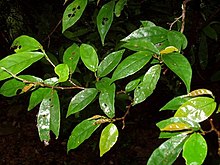Antidesma japonicum is a shrub in the family Phyllanthaceae. It is found in Southeast Asia, China and Japan. It provides food and fuel. A. japonicum has two accepted varieties: the nominate variety, A. japonicum var. japonicum; and the robustius variety, A. japonicum var. robustius.
| Antidesma japonicum | |
|---|---|

| |
| Scientific classification | |
| Kingdom: | Plantae |
| Clade: | Tracheophytes |
| Clade: | Angiosperms |
| Clade: | Eudicots |
| Clade: | Rosids |
| Order: | Malpighiales |
| Family: | Phyllanthaceae |
| Genus: | Antidesma |
| Species: | A. japonicum
|
| Binomial name | |
| Antidesma japonicum | |
| Synonyms | |
| |
Description
editIn China, the nominate variety grows as shrub or small tree, some 2 to 8 m tall.[4] Its light olive to greyish-green leaves are elliptic, oblong-elliptic, oblong-lanceolate, even obovate, some 3.5–13 cm by 1.5–4.5 cm in size. The inflorescences grow terminally or axillary. The drupes are a laterally compressed ellipsoid shape, 5–6 by 4–6 mm in size. If flowers from April to August, and fruits from June to September. In Cambodia it is described as a winding shrub some 1–2 m tall.[5]
Antidesma japonicum var. robustius is endemic to eastern Thailand.[6] The most obvious difference with the nominate variety is that the midrib of the leaves is distinctly raised adaxially.[4] It occurs in the Dry Evergreen Forest formations of Pak Thong Chai District, Nakhon Ratchasima Province, at about 350-500m.[7] It is given a Rare (Globally) status in Thailand.
Habitat
editGrowing in open forests in humid valleys of southern and eastern China, it occurs rarely in scrub on limestone, and is found at elevations of 300–1700m.[4] In Cambodia it occurs in secondary forest formations.[5]
Distribution
editIt is found in Peninsular Malaysia; Thailand; Myanmar; China (Tibet, Qinghai, Sichuan, Hubei, Anhui, Jiangsu, Zhejiang, Jiangxi, Fujian, Guangdong, Hunan, Guangxi, Hainan, Guizhou, Yunnan); Japan (including Nansei-shoto); Taiwan; Philippines (Luzon and Mindanao); Vietnam; and Cambodia.[3][4][8]
Conservation
editPopulations are severely fragmented and there is a continuing decline of mature individuals. However the very wide distribution of the tree, its large population, its seemingly not currently experiencing major threats while no significant future threats have been identified, means that IUCN assesses it as Least Concern.[1]
Vernacular names
editUses
editThe fruit is edible and the stem and branches make excellent firewood.[5]
Amongst Kuy- and Khmer-speaking people living in the same villages in Stung Treng and Preah Vihear provinces of north-central Cambodia, the tree is used as source of medicine and food, and as a component in ritual/magical activities.[9]
References
edit- ^ a b Ye, J.F.; Botanic Gardens Conservation International (BGCI).; IUCN SSC Global Tree Specialist Group (2019). "Antidesma japonicum". IUCN Red List of Threatened Species. 2019: e.T147638496A147638498. doi:10.2305/IUCN.UK.2019-2.RLTS.T147638496A147638498.en. Retrieved 19 November 2021.
- ^ "Antidesma japonicum Siebold & Zucc., Abh. Math.-Phys. Cl. Königl. Bayer. Akad. Wiss. 4(3): 212 (1846)". International Plant Name Index. Royal Botanic Gardens, Kew. Retrieved 30 April 2020.
- ^ a b "Antidesma japonicum var. japonicum". Plants of the World Online (POWO). Royal Botanic Gardens, Kew/Science. Retrieved 30 April 2020.
- ^ a b c d e f "9. Antidesma japonicum Siebold & Zuccarini, Abh. Math.-Phys. Cl. Königl. Bayer. Akad. Wiss. 4(3): 212. 1846". Flora of China. 11. eFloras.org: 210, 213. Retrieved 30 April 2020.
- ^ a b c d Dy Phon, Pauline (2000). Plants Used In Cambodia/Plantes utilisées au Cambodge. Phnom Penh: Imprimerie Olympic. p. 304.
- ^ "Antidesma japonicum var. robustius". Plants of the World Online (POWO). Royal Botanic Gardens, Kew/Science. Retrieved 30 April 2020.
- ^ Thawatchai Santisuk; et al. (2006). Thailand Red Data: Plants (PDF). Office of Natural Resources and Environmental Policy and Planning. Retrieved 30 April 2020.
- ^ a b c "Taxon: Antidesma japonicum Siebold & Zucc". U.S. National Plant Germplasm System. USDA, Agricultural Research Service, National Plant Germplasm System. 2020. Germplasm Resources Information Network (GRIN-Taxonomy). Retrieved 30 April 2020.
- ^ Turreira Garcia, Nerea; Argyriou, Dimitrios; Chhang, Phourin; Srisanga, Prachaya; Theilade, Ida (2017). "Ethnobotanical knowledge of the Kuy and Khmer people in Prey Lang, Cambodia" (PDF). Cambodian Journal of Natural History (1). Centre for Biodiversity Conservation, Phnom Penh: 76–101. Retrieved 22 April 2020.
